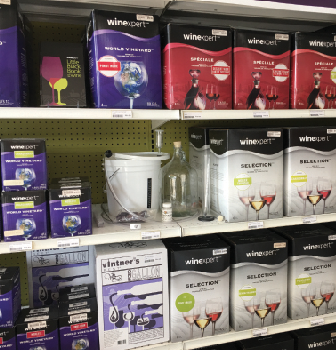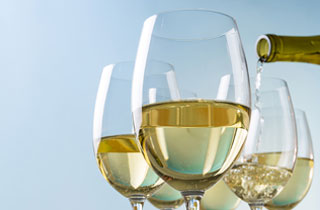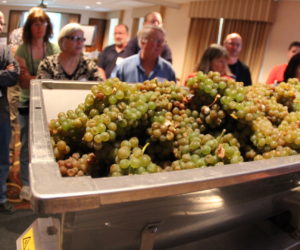
But wait a minute. If you’re in the United States and you think of good wine and sun-drenched vineyards stretching over the hills for as far as the eye can see, the Canadian flag usually isn’t flying in the background.
Well, look again. When it comes to selecting a winemaking kit, Canada has as many choices as it has cold nights. When high “sin” taxes on the purchase of wine spurred a desire for Canadian citizens to take up the hobby of winemaking, Canadian entrepreneurs weren’t far behind, packaging juice and cashing in on this hot market.
There are now dozens of wine suppliers, mostly Canadian, who collect juices and concentrates from around the world. They “process” the juice by balancing and blending to make select recipes, sometimes removing water, and repackaging into sterilized, air-free containers. Most now have distribution channels into the United States, and quality wine kits are finally finding their way into US home beer and wine supply stores.
Home winemakers living in the United States are not as fortunate as the Canadians (about the wine choices, not the cold nights or taxes), but the selection is growing. Whether you’re a beginner or an advanced winemaker with several bottles of vintage wine already tucked away, reading the outside of the wine kit box probably won’t tell you much.
For the novice, confusion is the order of the day. It’s a new world with its own language, strange equipment, and how-to books that all offer their own versions of the best way to make wine. You hate to ask a dumb-sounding question but don’t want to walk out empty handed either. After all, you want to make wine but you need somewhere to start.
The Basics
Wine is simply fermented juice, usually grape juice. For discussion purposes, stick with grape juice. The most important part of any wine kit is the juice. If you start with good grapes or good juice, your chances of making good wine are also good. If you start with poor juice, you are probably wasting your time and your money.
Most wine kits use juice concentrates. These concentrates are quite simply grape juice with the water removed. How much water is removed will vary with each producer and each product line. Some kits have 100 percent of the water removed. Here, each kit contains only dry ingredients.
However, most concentrates are liquid and, as you can imagine, the cost goes up as the percent of juice goes up. Some are packed in small cans, others in big boxes. The bulk of the more popular concentrates require you to add back 25 percent to 75 percent of the water to bring it to original condition. If you’re a purist, you look for 100 percent pure, fresh vinifera grape juices from Europe and around the world.
Other ingredients are often included in a wine kit. These additions usually include such things as a clarifier, stabilizer, oak powder, and the all-important cultured wine yeast. Other than ensuring that they are included, don’t worry too much about these ingredients. Detailed instructions for their use come with every kit.
If you’re in the mood for a nice Merlot, a dry Chardonnay, a delicate rosé, or an ice wine, port, or maybe a dessert wine, you can find these and many other recipes. In the United States you may still have a relatively small selection at your local supply store, but it most certainly will carry the popular styles for your area.
Beginners
A good place to start is at your local home winemaking shop. Ask the advice of an experienced retailer. In some areas there’s also the option of a wine-on-premise. This kind of facility has equipment, ingredients, recipes, and expertise to take you through the whole process.
Okay, you’ve found help, but there are plenty of kits out there, with prices from A to Z. So how much should you pay? Just because you’re a beginner doesn’t mean you should settle for the cheapest kit on the market. This is not like buying a tennis racket, where the beginners get the low-priced stuff and the pros head for the top of the line. You likely already have a taste for good wine and are looking to enhance your knowledge and skills associated with this interest.
Forget the cost of the kit and take a look at the cost per bottle. It is embarrassingly low. Why have a less-than-average bottle of wine when you can have a knock-your-socks-off bottle for only a few dollars more? If you are going to invest your time in this process, give yourself a chance to hit the jackpot with a great-tasting wine.
There are many good four-week kits available. Starting from seven kilograms (less than two gallons) of concentrate and following the simple instructions, you will have a drinkable wine in just four weeks. Of course a bit of bottle aging will make a huge improvement in the final product. This is a good place to start. The selection is good, the procedures are simple, and the rewards come quickly. What more could you want? Almost all of them are for five-gallon batches (21 liters), about 27 750-milliliter bottles of wine.
Select the variety you like, but before you purchase it, open the box and check it for simple, understandable instructions. It should also contain all the necessary measured ingredients to complete the whole process, as well as a list of the required equipment.
If you’re in a store that carries equipment, now is a good time to pick up what you need. Don’t go overboard. Stick to the basics for now. Fancy gadgets are not necessary to make a good batch of wine. You won’t need much more than a plastic fermenter, hydrometer, glass carboy, measuring cups, long food-grade plastic spoon, and siphon hoses.
When you get home, check the color of the concentrate. White wine concentrate should be pale gold, and red wine concentrate should be a rich, dark red; it should never be brown. A brown color denotes an older, poorly stored concentrate. Some suppliers may color their juice, making it more difficult to examine, but if you have any doubts, take it back. Also, check to ensure that the package is properly sealed. It should show no signs of leakage.
Follow instructions, be patient, and enjoy. Your first batch is always the one you’ll remember the most.
More Advanced
You’ve gotten a few successes under your belt, not to mention a few bottles in the cellar, and now you’re ready for more.
When concentrates are made, only the water is removed. All the character, color, and flavor of the grapes remains. When you reconstitute with water, the juice is whole again, and you are a lot richer for not having paid to ship all that water from the vineyard to the packager to you.
When you are making the wine at home you can reconstitute to 20 liters instead of 21 for a more robust flavor.
Some will argue for purity, as did an orange juice company that sold only fresh orange juice, no concentrates. The scene for its commercial was a heavy rainstorm over an orange grove in Florida, and the announcer’s only line was, “We’re now adding water to our orange juice.” Somehow, you can’t argue with mother nature’s way. You know you’re going to pay more for fresh juice, but to some it is worth it.
For the more adventurous and for those with the most discriminating taste, 100 percent juice is available. A 21-liter container of 100 percent pure, fresh varietal juice from vineyards around the world provides the ultimate in wine kits. For the kit producers this is their top of the line, their luxury edition, and in many cases their limited edition.
Certificates of authenticity and other assurances of a producer’s pride are often included. The kits may be available for only a few months each year and, in some cases, you may have to reserve your order well in advance. These kits can be made in eight weeks plus, but many are best when aged for two years. As you can imagine, the selection is also limited to just a few of the most popular reds and whites.
Taking this one step further, you can now venture into the world of acid test kits, sugar content, and adding your own nutrients and other additives. This is an experiment that offers the chance to produce a wine perfectly suited to your individual taste. But this is a big step and an expensive one that you may not need to take yet.
A more logical advancement from the four-week kits is the six-week kits. Starting with 15 liters of juice concentrate, you’ll be enjoying an exceptionally good wine in as little as six weeks from box to bottle. The six-week kits usually have a higher percentage of juice (as opposed to concentrate) than the four-week kits. The top producers provide an excellent selection of these kits, and some guarantee 100 percent varietal juice. Purists shouldn’t worry too much, because only a relatively small amount of water is added.
For economy, fast aging, and a professional-quality product, these kits can’t be beat. Your investment of labor, time, and price per bottle is only slightly more than the four-week kits, but the rewardsare there, especially if you can be patient for a few months while the flavors develop in the bottle.
Other Considerations
If you’re planning to serve your wine at a particular event or if you’re hoping to give it away as wedding favors or Christmas gifts, take a good look at the calendar before choosing the kit. A 21-day kit may be all you have time for. Usually big events are planned well enough in advance and Christmas still falls on December 25th, so start counting backward. Allow a few days to collect all the goodies, add in your box-to-bottle time, and add in bottle-aging time.
All wines are drinkable at bottling, but all will improve with bottle aging. You won’t make a big impression by serving your wine too young, so factor in proper aging time based on your own experience, the recommendations of the producer, and the suggestions of the retailer.
The selection of wine styles available to the US market is growing rapidly, but how does an itinerant winemaker choose the richest Cabernet Sauvignon or the driest Chardonnay? One producer may have the exceptional Cabernet but only an average Chardonnay. Another may produce just the opposite. Quality will vary within each product line. A retailer may carry only one line of four-week kits (including the average Chardonnay) and another line of 21-day canned kits. If you want a Chardonnay now and don’t want to shop somewhere else, you’re stuck.
Because you can’t make them all and sort out the exceptional from the average, you’re going to have to ask a lot of questions. What are the most popular sellers? Also ask about home winemaking clubs that are cropping up more and more across the country. Fellow winemakers are generally more than happy to share information and make suggestions.
With improved selection and availability home winemakers can enjoy great-tasting wine the first time and every time.




